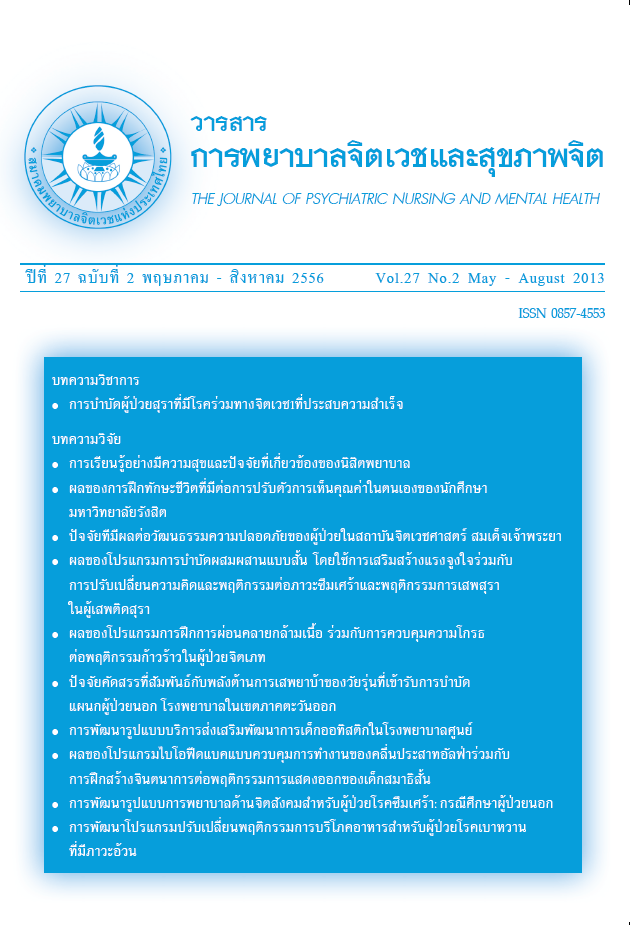การเรียนรู้อย่างมีความสุขและปัจจัยที่เกี่ยวข้องของนิสิตพยาบาล
Main Article Content
บทคัดย่อ
บทคัดย่อ
การวิจัยเชิงความสัมพันธ์แบบทำนายนี้มีวัตถุประสงค์ คือ 1) เพื่อศึกษาและเปรียบเทียบ การเรียนรู้อย่างมีความสุขระหว่างชั้นปีที่ 1 ถึงชั้นปีที่ 4 2) เพื่อศึกษาความสัมพันธ์ระหว่าง ปัจจัยภายในตัวนิสิตได้แก่ ภาวะสุขภาพของนิสิตพยาบาล ความฉลาดทางอารมณ์ ความสามารถในการปรับตัวในมหาวิทยาลัย ปัจจัยภายนอกตัวนิสิต ได้แก่ ลักษณะเพื่อนร่วมมหาวิทยาลัย ลักษณะอาจารย์ ลักษณะคณะพยาบาลศาสตร์ ลักษณะบิดา มารดา/ผู้ปกครอง กับการเรียนรู้อย่างมีความสุข ของนิสิตพยาบาล 3) เพื่อศึกษาปัจจัยที่สามารถพยากรณ์การเรียนรู้อย่างมีความสุขของนิสิตพยาบาล กลุ่มตัวอย่างคือนิสิตพยาบาลของมหาวิทยาลัยแห่งหนึ่งในภาคตะวันออกจำนวน 300 คน ซึ่งได้จากการสุ่มแบบแบ่งชั้นตามสัดส่วนเครื่องมือที่ใช้ในการวิจัย ได้แก่ 1) แบบสอบถามข้อมูลส่วนบุคคล 2) แบบสอบถามปัจจัยภายในตัวนิสิต ได้แก่ ภาวะสุขภาพทั่วไปฉบับย่อ แบบประเมินความฉลาดทางอารมณ์ และแบบสอบถามความสามารถในการปรับตัวในมหาวิทยาลัย ได้ค่าความเที่ยงของเครื่องมือเท่ากับ .73, .83, .93 ตามลำดับ 3) แบบสอบถามปัจจัยภายนอกตัวนิสิต ได้แก่ ลักษณะเพื่อนร่วมมหาวิทยาลัย ลักษณะอาจารย์ ลักษณะคณะพยาบาลศาสตร์ และลักษณะบิดามารดา/ผู้ปกครอง ได้ค่าความเที่ยงของเครื่องมือเท่ากับ .79, .94, .92 และ .92 ตามลำดับ และ 4) แบบสอบถามการเรียนรู้อย่างมีความสุขของนิสิตพยาบาลได้ค่าความเที่ยงของเครื่องมือเท่ากับ .92 สถิติที่ใช้ในการวิเคราะห์ข้อมูล ได้แก่ การแจกแจงความถี่ ร้อยละ ค่าเฉลี่ย ส่วนเบี่ยงเบนมาตรฐาน การทดสอบความแปรปรวนแบบทางเดียว สัมประสิทธิ์สหสัมพันธ์ของเพียร์สัน และสมการถดถอยพหุคูณแบบขั้นตอนผลการศึกษา 1) ระดับคะแนนเฉลี่ยการเรียนรู้อย่างมีความสุขอยู่ในระดับสูง (Mean = 3.02; S.D. = 0.26) คะแนนเฉลี่ยการเรียนรู้อย่างมีความสุขของนิสิตชั้นปีที่ 3 และชั้นปีที่ 4 แตกต่างกันอย่างมีนัยสำคัญทางสถิติ (p<.05) 2) ความฉลาดทางอารมณ์ ความสามารถในการปรับตัวในมหาวิทยาลัย ลักษณะของ เพื่อนร่วมมหาวิทยาลัย อาจารย์ คณะพยาบาลศาสตร์ และลักษณะบิดา มารดา/ผู้ปกครอง มีความสัมพันธ์ทางบวกในระดับปานกลางกับการเรียนรู้อย่างมีความสุขของนิสิตพยาบาล อย่างมีนัยสำคัญทางสถิติ, p<.05 (r = .623, .618, 514, .522, .447, และ .411, ตามลำดับ), และภาวะสุขภาพมีความสัมพันธ์ทางลบในระดับต่ำกับ การเรียนรู้อย่างมีความสุขของนิสิตพยาบาล อย่างมีนัยสำคัญทางสถิติ (p<.05; r = .198) 3) ความฉลาดทางอารมณ์, ลักษณะอาจารย์, ลักษณะคณะพยาบาลศาสตร์, ลักษณะเพื่อนร่วมมหาวิทยาลัย และความสามารถในการปรับตัวในมหาวิทยาลัย สามารถร่วมกันพยากรณ์ การเรียนรู้อย่างมีความสุขของนิสิตพยาบาลได้ร้อยละ 57.1%
Abstract
The purpose of the predictive correlational study were: 1) to describe and compare happy learning between the 1 st and 4th year nursing students 2) to investigate the correlation between students’ internal factors including students’ health status, emotional quotient, and adjustment to the university environment, students’ external factors including characteristics of university friends, teachers, educational institutions, father/mother or parent and happy learning among undergraduate nursing students and 3) to examine the predictors of happy leaning among these nursing students. Samples of 300 nursing students of the university located in the Eastern part of Thailand were used by Stratified random sampling. Self-report questionnaires assessing general data, students’ internal factors and students’ external factors were used. The reliabilities regarding 1) students’ internal factors including students’ health status, emotional quotient, and adjustment to the university environment were .73, .83, and .93, respectively, 2) students’ external factors including characteristics of university friends, teachers, educational institutions, father/mother or parent were .79, .94, .92, and 92, respectively., 3) Its reliability of happy leaning was .92. Frequency, percentage, mean and standard deviation, One-way ANOVA, Pearson’s correlation coefficient, and stepwise multiple regression were employed to analyze the data.
Results were: 1) An average score of happy learning in the high level (Mean=3.02; S.D.= 0.26). Happy learning was significantly different between students in the 3rd and 4th years (p<.05), 2) Emotional quotient, students’ adjustment to the university environment, characteristics of university friends, teachers, nursing institution, and father/mother or parent had a moderate positive correlation with happy learning in a significant difference (p <.05, r = .623, .618,status, emotional quotient, and adjustment to the university environment were .73, .83, and .93, respectively, 2) students’ external factors including characteristics of university friends, teachers, educational institutions, father/mother or parent were .79, .94, .92, and 92, respectively., 3) Its reliability of happy leaning was .92. Frequency, percentage, mean and standard deviation, One-way ANOVA, Pearson’s correlation coefficient, and stepwise multiple regression were employed to analyze the data. Results were: 1) An average score of happy learning in the high level (Mean=3.02; S.D.= 0.26). Happy learning was significantly different between students in the 3rd and 4th years (p<.05), 2) Emotional quotient, students’ adjustment to the university environment, characteristics of university friends, teachers, nursing institution, and father/mother or parent had a moderate positive correlation with happy learning in a significant difference (p <.05, r = .623, .618,.514, .522, .447, and .411, respectively), whereas students’ health status had a negative correlation with happy learning in the low level (p<.05, r = .198), 3) emotional quotient, characteristics of teachers, nursing institution, university friends, and students’ adjustment to the university environment could moderately explain variance of happy learning for 57.1%
Article Details
ประเภทบทความ
บทความวิจัย
บทความที่ได้รับการตีพิมพ์แล้ว เป็นลิขสิทธิ์ของสมาคมพยาบาลจิตเวชแห่งประเทศไทย


